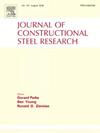考虑不确定性和加载速度的受拉钢螺栓广义弹簧模型
IF 4
2区 工程技术
Q1 CONSTRUCTION & BUILDING TECHNOLOGY
引用次数: 0
摘要
量化连接件的转动延性是研究钢结构在极端危险和荷载情况下的鲁棒性的关键。在部分强度螺栓连接中,最终破坏状态通常由螺栓断裂决定。采用实体有限元模型模拟螺栓,由于计算量大、材料损伤参数校准过程长,不便于实际应用。此外,目前的螺栓模型没有捕捉到与螺栓延伸能力相关的不确定性。为了解决这些挑战,提出了一个三线性经验弹簧模型,以准确地捕捉螺栓的响应,直到失效,同时纳入不确定性;从而支持有关可靠性和基于性能的工程的研究。开发了两个多元经验表达式来预测螺栓的弹性刚度和塑性伸长,作为其尺寸,等级,抓地力和螺纹长度的函数,在广泛的螺栓几何形状范围内提供更高的精度。这些表达式来源于单轴拉伸下螺栓组合的广泛数据集,从文献中编译并补充了200个新测试样本。提出的模型适用于采用轴向连接器的有限元模拟,基于数值力学的分析或设计应用。该模型在不同螺栓等级和连接拓扑的构件和节点尺度上进行了实验验证,突出了螺栓响应不确定性对节点级延性的影响。高加载速度对锚杆响应参数的影响也被量化。本文章由计算机程序翻译,如有差异,请以英文原文为准。

Generalized spring model for steel bolts in tension considering uncertainty and loading speed
Quantifying the rotational ductility of connections is key to studying the robustness of steel structures under extreme hazards and loading scenarios. In partial-strength bolted steel connections, the ultimate failure state is typically governed by bolt rupture. Simulating bolts using solid finite element models can be inconvenient for practical applications due to high computational demands and lengthy calibration procedures of the material damage parameters. Additionally, current bolt models do not capture the uncertainty associated with the bolt's elongation capacity. To address these challenges, a trilinear empirical spring model is proposed to accurately capture the bolt response up to failure while incorporating uncertainty; thereby supporting studies related to reliability and performance-based engineering. Two multi-variate empirical expressions are developed to predict the bolt's elastic stiffness and plastic elongation, as a function of its size, grade, grip, and thread lengths, providing improved accuracy across a wide range of bolt geometries. These expressions are derived from an extensive dataset of bolt assemblies under uniaxial tension, compiled from literature and supplemented by 200 newly tested specimens. The proposed model is applicable in finite element simulations employing axial connectors, numerical mechanics-based analyses, or design applications. The model is validated against experimental data at both the component and joint scales for various bolt grades and connection topologies, highlighting the impact of the bolt's response uncertainty on the joint-level ductility. The implications of high loading speed, representative of real dynamic hazard, on the bolt's response parameters are also quantified.
求助全文
通过发布文献求助,成功后即可免费获取论文全文。
去求助
来源期刊

Journal of Constructional Steel Research
工程技术-工程:土木
CiteScore
7.90
自引率
19.50%
发文量
550
审稿时长
46 days
期刊介绍:
The Journal of Constructional Steel Research provides an international forum for the presentation and discussion of the latest developments in structural steel research and their applications. It is aimed not only at researchers but also at those likely to be most affected by research results, i.e. designers and fabricators. Original papers of a high standard dealing with all aspects of steel research including theoretical and experimental research on elements, assemblages, connection and material properties are considered for publication.
 求助内容:
求助内容: 应助结果提醒方式:
应助结果提醒方式:


